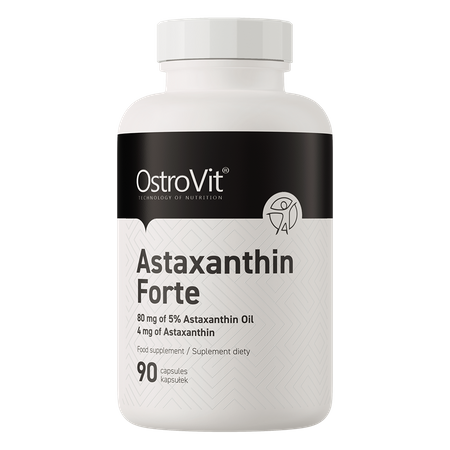Astaxanthin
Astaxanthin is one of the strongest antioxidants that naturally occurs mainly in algae. Due to its health-promoting properties and wide spectrum of action, it is called the queen of carotenoids.
What is astaxanthin?
Astaxanthin (3,3'-dihydroxy-β, β-carotene-4,4'-dione) is a chemical compound from the group of carotenoids, more precisely an organic xanthophyll. It is characterized by red-pink coloration and is sometimes used as a food dye (E161j).
It is formed as a result of chemical transformations taking place in cells from zeaxanthin and cataxanthin.
Man cannot synthesize astaxanthin, so the only solution is to provide the compound to the body with food or in the form of dietary supplements.
Sources of astaxanthin
Astaxanthin is obtained from natural sources or obtained as a result of multi-stage chemical synthesis. Naturally, the substance is produced by:
- Haematococcus pluvialis algae,
- algae Chlorella zofingensis,
- yeast Phaffia rhodozyma,
- bacteria Argobacterium auranticum, Mycobacterium laticola, Brevibacterium spp.
On an industrial scale, astaxanthin is mainly used, which is produced by the algae Haematococcus pluvialis.
Since xanthophyll is consumed by fish and seafood and accumulates in their bodies, the sources of astaxanthin can also include organisms of animals such as shrimps, salmon, trout, crayfish, lobsters and crabs.
Interestingly, the characteristic color of flamingos is also the result of the presence of this carotenoid. In the organism of these animals, yellow zeaxanthin and orange beta-carotene are transformed into pink astaxanthin, which is responsible for the color of bird feathers.
Astaxanthin properties
Astaxanthin has strong antioxidant properties and is known mainly for its antioxidant effects. It can reduce oxidative stress, protect against the action of free radicals, and thus delay the aging process and protect against DNA damage to cells, mitochondria and lipid membranes.
It is considered one of the strongest antioxidants, because it has 65 times stronger effects than vitamin C and 50 times stronger than vitamin E.
Astaxanthin has a positive effect on the lipid profile, being able to reduce the concentration of LDL cholesterol and triglycerides, while increasing the concentration of HDL cholesterol. Thanks to this, the compound can contribute to reducing the risk of atherosclerosis and cardiovascular diseases.
The substance can lower blood glucose levels, increase insulin sensitivity, help preserve the ability of the pancreas to secrete insulin, and thus may reduce the risk of developing type II diabetes.
In addition, xanthophyll can have a beneficial effect on the body's immune system, relieve inflammation and reduce the risk of infection. This is mainly due to the confirmed anti-inflammatory and antioxidant effects of the compound.
In addition, the substance can improve the blood supply to the brain and positively affect memory. Astaxanthin crosses the blood-brain barrier, protecting the nervous system from free radicals. Research is ongoing on the possibility of using the compound in neurodegenerative diseases.
Xanthophyll also has a beneficial effect on the functioning of the organ of vision. Thanks to its ability to cross the blood-retinal barrier, astaxanthin can protect the eye from macular degeneration and inflammation. It can also reduce the symptoms of fatigue and dryness of the eye and improve the ability of the eyeball to accommodate.
The substance helps to cleanse the body of harmful toxins and also has a beneficial effect on the skin. Not only can it inhibit the aging process, but it is also a natural sunscreen and has a protective effect on contact with UV radiation. It also affects the elasticity of the skin, increases the level of its hydration and prevents the formation of discoloration. It also has a positive effect on the production of collagen and elastin. Thus, astaxanthin is used as an ingredient in many cosmetics.
Astaxanthin and physical activity
Astaxanthin, due to its properties, is also used in the world of sports. Xanthophyll has an anti-inflammatory effect and reduces pain by reducing the level of lactic acid formed during physical activity.
In addition, the substance accelerates regeneration, which has a positive effect on improving the efficiency of players, and thus translates into better sports results.
Astaxanthin captures free radicals formed during physical exertion. Xanthophyll also accelerates fat burning and provides better metabolism of fatty acids in the body.
What astaxanthin to choose and how to take it?
We have already mentioned that there are two possibilities of obtaining the compound - naturally from algae and marine organisms and artificially.
It is therefore worth noting that natural xanthophyll has a stronger antioxidant effect than synthetic one and is characterized by greater stability.
Astaxanthin in dietary supplements is usually found in the form of easy-to-swallow capsules and can contain both natural sources of the compound and artificial ones.
Recommended daily dose of the supplement is 2-8 mg of astaxanthin, depending on the reason for its use. In the case of using the compound prophylactically as an antioxidant, the recommended dose of the preparation is lower than when we use it, for example, during inflammation.
According to the U.S. Food and Drug Administration, known as the FDA, a person can safely take 7.8 to 12 mg per day of astaxanthin.
Since it is a lipophilic substance, it is worth taking it together with meals rich in fats to increase its bioavailability in the body.
It is worth remembering that dietary supplements should always be used in accordance with the recommendations on the packaging or leaflet of the preparation and not to exceed the recommended portions of products.
Contraindications and side effects
No side effects have been observed when using astaxanthin, however, it is recommended to take preparations with its participation in accordance with the manufacturer's or doctor's instructions.
Only people allergic to the product's ingredients or people allergic to seafood who reach for supplements containing xanthophylls of natural origin may experience allergic reactions.
There were also no contraindications to using the benefits of the compound.

